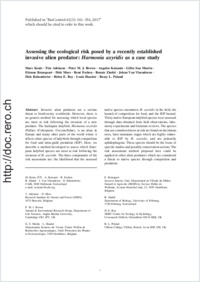Assessing the ecological risk posed by a recently established invasive alien predator: Harmonia axyridis as a case study
- Kenis, Marc CABI, Delémont, Switzerland
- Adriaens, Tim Research Institute for Nature and Forest (INBO), Brussels, Belgium
- Brown, Peter M. J. Animal & Environment Research Group, Department of Life Sciences, Anglia Ruskin University, Cambridge, UK
- Katsanis, Angelos CABI, Delémont, Switzerland - Department of Ecology and Evolutionary Biology, University of California – Irvine, USA
- Martin, Gilles San Département Sciences du Vivant, Centre Wallon de Recherches Agronomiques, Unité Protection des Plantes et Ecotoxicologie, Gembloux, Belgium
- Branquart, Etienne Invasive Species, UnitDépartement de l’Etude du Milieu Naturel et Agricole (DEMNA), Gembloux, Belgium
- Maes, Dirk Research Institute for Nature and Forest (INBO), Brussels, Belgium
- Eschen, René CABI, Delémont, Switzerland
- Zindel, Renate CABI, Delémont, Switzerland - Department of Biology, University of Fribourg, Switzerland
- Vlaenderen, Johan Van CABI, Delémont, Switzerland
- Babendreier, Dirk CABI, Delémont, Switzerland
- Roy, Helen E. NERC Centre for Ecology & Hydrology, Crowmarsh, Gifford, UK
- Hautier, Louis Département Sciences du Vivant, Centre Wallon de Recherches Agronomiques, Unité Protection des Plantes et Ecotoxicologie, Gembloux, Belgium
- Poland, Remy L. Clifton College Bristol, UK
-
01.06.2017
Published in:
- BioControl. - 2017, vol. 62, no. 3, p. 341–354
English
Invasive alien predators are a serious threat to biodiversity worldwide. However, there is no generic method for assessing which local species are most at risk following the invasion of a new predator. The harlequin ladybird, Harmonia axyridis (Pallas) (Coleoptera: Coccinellidae), is an alien in Europe and many other parts of the world where it affects other species of ladybirds through competition for food and intra-guild predation (IGP). Here, we describe a method developed to assess which European ladybird species are most at risk following the invasion of H. axyridis. The three components of the risk assessment are: the likelihood that the assessed native species encounters H. axyridis in the field, the hazard of competition for food, and the IGP hazard. Thirty native European ladybird species were assessed through data obtained from field observations, laboratory experiments and literature reviews. The species that are considered most at risk are found on deciduous trees, have immature stages which are highly vulnerable to IGP by H. axyridis, and are primarily aphidophagous. These species should be the focus of specific studies and possibly conservation actions. The risk assessment method proposed here could be applied to other alien predators which are considered a threat to native species through competition and predation.
- Faculty
- Faculté des sciences et de médecine
- Department
- Département de Biologie
- Language
-
- English
- Classification
- Biological sciences
- License
-
License undefined
- Identifiers
-
- RERO DOC 288908
- DOI 10.1007/s10526-016-9764-x
- Persistent URL
- https://folia.unifr.ch/unifr/documents/305436
Statistics
Document views: 161
File downloads:
- pdf: 173
